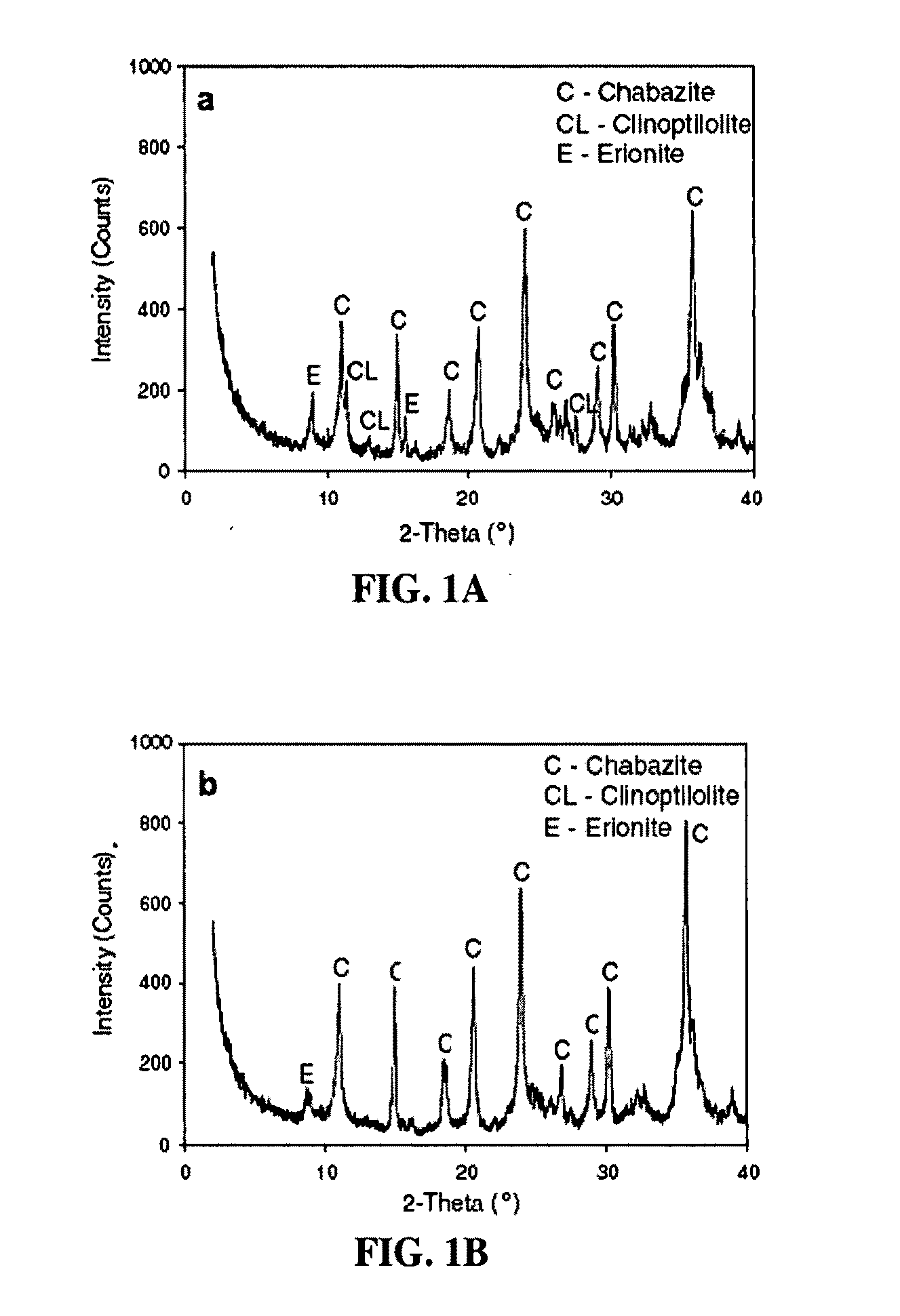Zeolite supported metallic nanodots
a technology of metal nanodots and zeolite, which is applied in the field of metal nanodots, can solve the problems of generating nanosilver, generating nanosilver, and zeolite supported metal nanoscale structures
- Summary
- Abstract
- Description
- Claims
- Application Information
AI Technical Summary
Benefits of technology
Problems solved by technology
Method used
Image
Examples
example 1
[0047]Sedimentary chabazite from the well-known deposit at Bowie, Ariz. was utilized as the zeolite support, obtained from GSA Resources of Tucson, Ariz. [21]. Aluminum enriched chabazites were prepared by prolonged digestion of the raw ore in alkaline silicate mixtures for 1-3 days at 80° C. The degree of aluminum enrichment was governed by the amount of excess alkalinity available during the digestion and recrystallization process.
[0048]Phase identification of chabazite and aluminum enriched analogs was conducted by X-ray diffraction analysis using a Rigaku Geigerflex Model 2173 diffractometer unit. As is typical of samples from the Bowie deposit, XRD analysis indicated that the material was highly zeolitized with chabazite being the dominant phase. The material also contained significant clinoptilolite and erionite as contaminants as seen in FIG. 1A. Caustic digested enhanced or aluminum enriched materials were found to gain intensity for the chabazite-like peaks while l...
example 2
Formation of Silver Nanodots
[0049]Silver ion-exchange was accomplished by exposure of the zeolites as 200 mesh powders to an excess of aqueous silver nitrate at room temperature with stirring for 1 hour. The exchanged materials were thoroughly washed with deionized water, and dried at 100° C. To convert the silver ions in the zeolite to supported metallic silver nanoparticles, the ion-exchanged chabazite was annealed at temperatures ranging from 150° C. to 450° C., for periods of 1-4 h in air.
[0050]Quantitative elemental analyses of the silver exchanged materials were conducted using Perkin Elmer Elan6000 quadrupole ICP-MS. Semi-quantitative elemental analysis of the material surfaces was conducted by XPS utilizing a Kratos AXIS 165 spectrometer using monochromated Al Kα (hv=1486.6 eV) radiation in fixed analyser transmission (FAT) mode. The pressure in the sample analysis chamber was less than 10−7 Pa (10−9 torr). Powder samples were mounted on stainless steel sample holders using ...
example 3
[0055]Transmission electron microscopy (TEM) was performed on a Philips Tecnai F20 Twin FEG, equipped with EDX, EFTEM / EELS, Annular Dark field Detector (ADF), and high angle tilting capability, located at the University of Calgary. The microscope was operated in scanning transmission (STEM) mode. Samples were prepared by dry grinding and dispersing materials onto copper grids. Quantitative particle size analysis was performed using SPIP™ microscopy image processing software.
[0056]Transmission electron microscopy (TEM) analysis, as seen in FIG. 3, illustrates the silver nanoparticle distribution on the mineral chabazite sample. Quantitative particle size analysis, shown in FIG. 4, reveals that the vast majority of the silver nanoparticles are in the order of about 1 to about 5 nm in diameter, with a mean of 2.6 nm. As seen in FIG. 5, higher magnification appears to show the silver as spherical nanodots resting on the chabazite surfaces, although other globular morp...
PUM
| Property | Measurement | Unit |
|---|---|---|
| size | aaaaa | aaaaa |
| temperature | aaaaa | aaaaa |
| temperature | aaaaa | aaaaa |
Abstract
Description
Claims
Application Information
 Login to View More
Login to View More - R&D
- Intellectual Property
- Life Sciences
- Materials
- Tech Scout
- Unparalleled Data Quality
- Higher Quality Content
- 60% Fewer Hallucinations
Browse by: Latest US Patents, China's latest patents, Technical Efficacy Thesaurus, Application Domain, Technology Topic, Popular Technical Reports.
© 2025 PatSnap. All rights reserved.Legal|Privacy policy|Modern Slavery Act Transparency Statement|Sitemap|About US| Contact US: help@patsnap.com



